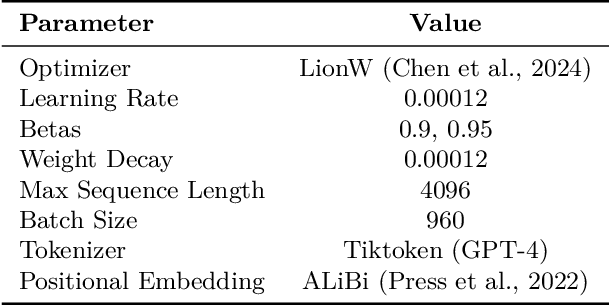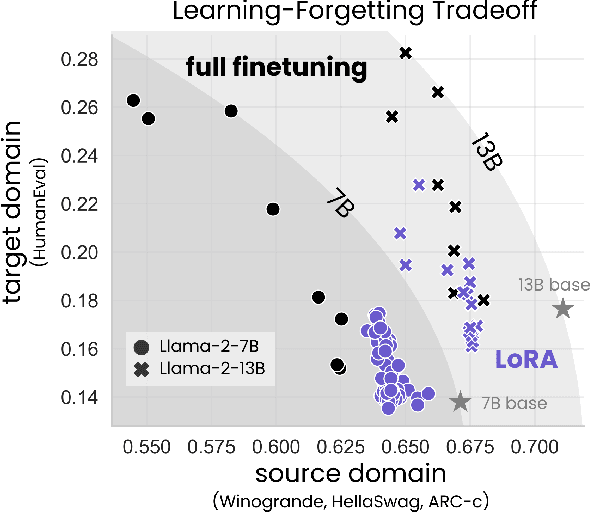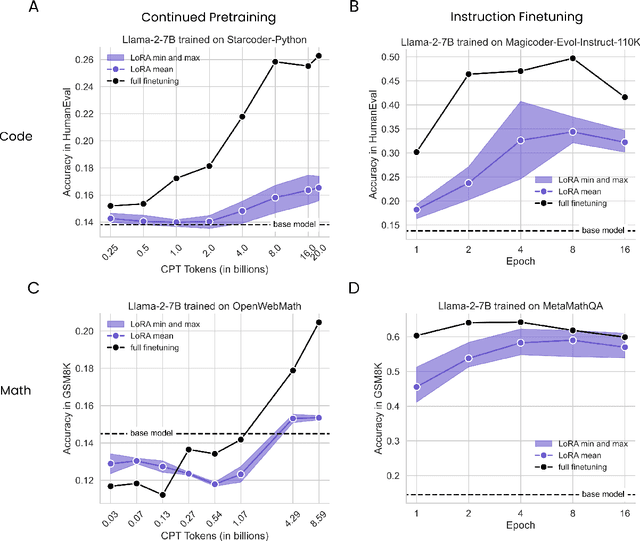Jonathan Frankle
Soup to go: mitigating forgetting during continual learning with model averaging
Jan 09, 2025Abstract:In continual learning, where task data arrives in a sequence, fine-tuning on later tasks will often lead to performance degradation on earlier tasks. This is especially pronounced when these tasks come from diverse domains. In this setting, how can we mitigate catastrophic forgetting of earlier tasks and retain what the model has learned with minimal computational expenses? Inspired by other merging methods, and L2-regression, we propose Sequential Fine-tuning with Averaging (SFA), a method that merges currently training models with earlier checkpoints during the course of training. SOTA approaches typically maintain a data buffer of past tasks or impose a penalty at each gradient step. In contrast, our method achieves comparable results without the need to store past data, or multiple copies of parameters for each gradient step. Furthermore, our method outperforms common merging techniques such as Task Arithmetic, TIES Merging, and WiSE-FT, as well as other penalty methods like L2 and Elastic Weight Consolidation. In turn, our method offers insight into the benefits of merging partially-trained models during training across both image and language domains.
Does your data spark joy? Performance gains from domain upsampling at the end of training
Jun 05, 2024



Abstract:Pretraining datasets for large language models (LLMs) have grown to trillions of tokens composed of large amounts of CommonCrawl (CC) web scrape along with smaller, domain-specific datasets. It is expensive to understand the impact of these domain-specific datasets on model capabilities as training at large FLOP scales is required to reveal significant changes to difficult and emergent benchmarks. Given the increasing cost of experimenting with pretraining data, how does one determine the optimal balance between the diversity in general web scrapes and the information density of domain specific data? In this work, we show how to leverage the smaller domain specific datasets by upsampling them relative to CC at the end of training to drive performance improvements on difficult benchmarks. This simple technique allows us to improve up to 6.90 pp on MMLU, 8.26 pp on GSM8K, and 6.17 pp on HumanEval relative to the base data mix for a 7B model trained for 1 trillion (T) tokens, thus rivaling Llama-2 (7B)$\unicode{x2014}$a model trained for twice as long. We experiment with ablating the duration of domain upsampling from 5% to 30% of training and find that 10% to 20% percent is optimal for navigating the tradeoff between general language modeling capabilities and targeted benchmarks. We also use domain upsampling to characterize at scale the utility of individual datasets for improving various benchmarks by removing them during this final phase of training. This tool opens up the ability to experiment with the impact of different pretraining datasets at scale, but at an order of magnitude lower cost compared to full pretraining runs.
LoRA Learns Less and Forgets Less
May 15, 2024



Abstract:Low-Rank Adaptation (LoRA) is a widely-used parameter-efficient finetuning method for large language models. LoRA saves memory by training only low rank perturbations to selected weight matrices. In this work, we compare the performance of LoRA and full finetuning on two target domains, programming and mathematics. We consider both the instruction finetuning ($\approx$100K prompt-response pairs) and continued pretraining ($\approx$10B unstructured tokens) data regimes. Our results show that, in most settings, LoRA substantially underperforms full finetuning. Nevertheless, LoRA exhibits a desirable form of regularization: it better maintains the base model's performance on tasks outside the target domain. We show that LoRA provides stronger regularization compared to common techniques such as weight decay and dropout; it also helps maintain more diverse generations. We show that full finetuning learns perturbations with a rank that is 10-100X greater than typical LoRA configurations, possibly explaining some of the reported gaps. We conclude by proposing best practices for finetuning with LoRA.
BioMedLM: A 2.7B Parameter Language Model Trained On Biomedical Text
Mar 27, 2024Abstract:Models such as GPT-4 and Med-PaLM 2 have demonstrated impressive performance on a wide variety of biomedical NLP tasks. However, these models have hundreds of billions of parameters, are computationally expensive to run, require users to send their input data over the internet, and are trained on unknown data sources. Can smaller, more targeted models compete? To address this question, we build and release BioMedLM, a 2.7 billion parameter GPT-style autoregressive model trained exclusively on PubMed abstracts and full articles. When fine-tuned, BioMedLM can produce strong multiple-choice biomedical question-answering results competitive with much larger models, such as achieving a score of 57.3% on MedMCQA (dev) and 69.0% on the MMLU Medical Genetics exam. BioMedLM can also be fine-tuned to produce useful answers to patient questions on medical topics. This demonstrates that smaller models can potentially serve as transparent, privacy-preserving, economical and environmentally friendly foundations for particular NLP applications, such as in biomedicine. The model is available on the Hugging Face Hub: https://huggingface.co/stanford-crfm/BioMedLM.
MosaicBERT: A Bidirectional Encoder Optimized for Fast Pretraining
Jan 16, 2024



Abstract:Although BERT-style encoder models are heavily used in NLP research, many researchers do not pretrain their own BERTs from scratch due to the high cost of training. In the past half-decade since BERT first rose to prominence, many advances have been made with other transformer architectures and training configurations that have yet to be systematically incorporated into BERT. Here, we introduce MosaicBERT, a BERT-style encoder architecture and training recipe that is empirically optimized for fast pretraining. This efficient architecture incorporates FlashAttention, Attention with Linear Biases (ALiBi), Gated Linear Units (GLU), a module to dynamically remove padded tokens, and low precision LayerNorm into the classic transformer encoder block. The training recipe includes a 30% masking ratio for the Masked Language Modeling (MLM) objective, bfloat16 precision, and vocabulary size optimized for GPU throughput, in addition to best-practices from RoBERTa and other encoder models. When pretrained from scratch on the C4 dataset, this base model achieves a downstream average GLUE (dev) score of 79.6 in 1.13 hours on 8 A100 80 GB GPUs at a cost of roughly $20. We plot extensive accuracy vs. pretraining speed Pareto curves and show that MosaicBERT base and large are consistently Pareto optimal when compared to a competitive BERT base and large. This empirical speed up in pretraining enables researchers and engineers to pretrain custom BERT-style models at low cost instead of finetune on existing generic models. We open source our model weights and code.
* 10 pages, 4 figures in main text. 25 pages total
Dataset Difficulty and the Role of Inductive Bias
Jan 03, 2024Abstract:Motivated by the goals of dataset pruning and defect identification, a growing body of methods have been developed to score individual examples within a dataset. These methods, which we call "example difficulty scores", are typically used to rank or categorize examples, but the consistency of rankings between different training runs, scoring methods, and model architectures is generally unknown. To determine how example rankings vary due to these random and controlled effects, we systematically compare different formulations of scores over a range of runs and model architectures. We find that scores largely share the following traits: they are noisy over individual runs of a model, strongly correlated with a single notion of difficulty, and reveal examples that range from being highly sensitive to insensitive to the inductive biases of certain model architectures. Drawing from statistical genetics, we develop a simple method for fingerprinting model architectures using a few sensitive examples. These findings guide practitioners in maximizing the consistency of their scores (e.g. by choosing appropriate scoring methods, number of runs, and subsets of examples), and establishes comprehensive baselines for evaluating scores in the future.
Beyond Chinchilla-Optimal: Accounting for Inference in Language Model Scaling Laws
Dec 31, 2023



Abstract:Large language model (LLM) scaling laws are empirical formulas that estimate changes in model quality as a result of increasing parameter count and training data. However, these formulas, including the popular DeepMind Chinchilla scaling laws, neglect to include the cost of inference. We modify the Chinchilla scaling laws to calculate the optimal LLM parameter count and pre-training data size to train and deploy a model of a given quality and inference demand. We conduct our analysis both in terms of a compute budget and real-world costs and find that LLM researchers expecting reasonably large inference demand (~1B requests) should train models smaller and longer than Chinchilla-optimal.
CommonCanvas: An Open Diffusion Model Trained with Creative-Commons Images
Oct 25, 2023



Abstract:We assemble a dataset of Creative-Commons-licensed (CC) images, which we use to train a set of open diffusion models that are qualitatively competitive with Stable Diffusion 2 (SD2). This task presents two challenges: (1) high-resolution CC images lack the captions necessary to train text-to-image generative models; (2) CC images are relatively scarce. In turn, to address these challenges, we use an intuitive transfer learning technique to produce a set of high-quality synthetic captions paired with curated CC images. We then develop a data- and compute-efficient training recipe that requires as little as 3% of the LAION-2B data needed to train existing SD2 models, but obtains comparable quality. These results indicate that we have a sufficient number of CC images (~70 million) for training high-quality models. Our training recipe also implements a variety of optimizations that achieve ~3X training speed-ups, enabling rapid model iteration. We leverage this recipe to train several high-quality text-to-image models, which we dub the CommonCanvas family. Our largest model achieves comparable performance to SD2 on a human evaluation, despite being trained on our CC dataset that is significantly smaller than LAION and using synthetic captions for training. We release our models, data, and code at https://github.com/mosaicml/diffusion/blob/main/assets/common-canvas.md
Dynamic Masking Rate Schedules for MLM Pretraining
May 24, 2023Abstract:Most works on transformers trained with the Masked Language Modeling (MLM) objective use the original BERT model's fixed masking rate of 15%. Our work instead dynamically schedules the masking ratio throughout training. We found that linearly decreasing the masking rate from 30% to 15% over the course of pretraining improves average GLUE accuracy by 0.46% in BERT-base, compared to a standard 15% fixed rate. Further analyses demonstrate that the gains from scheduling come from being exposed to both high and low masking rate regimes. Our results demonstrate that masking rate scheduling is a simple way to improve the quality of masked language models and achieve up to a 1.89x speedup in pretraining.
Knowledge Distillation for Efficient Sequences of Training Runs
Mar 11, 2023



Abstract:In many practical scenarios -- like hyperparameter search or continual retraining with new data -- related training runs are performed many times in sequence. Current practice is to train each of these models independently from scratch. We study the problem of exploiting the computation invested in previous runs to reduce the cost of future runs using knowledge distillation (KD). We find that augmenting future runs with KD from previous runs dramatically reduces the time necessary to train these models, even taking into account the overhead of KD. We improve on these results with two strategies that reduce the overhead of KD by 80-90% with minimal effect on accuracy and vast pareto-improvements in overall cost. We conclude that KD is a promising avenue for reducing the cost of the expensive preparatory work that precedes training final models in practice.
 Add to Chrome
Add to Chrome Add to Firefox
Add to Firefox Add to Edge
Add to Edge